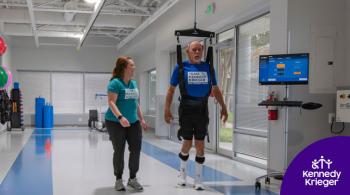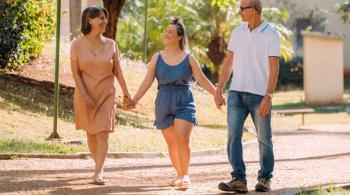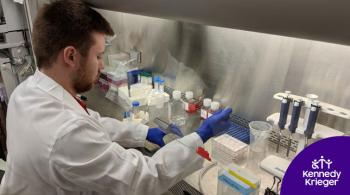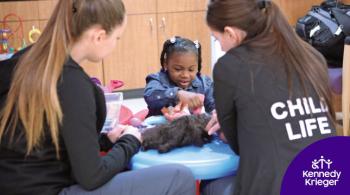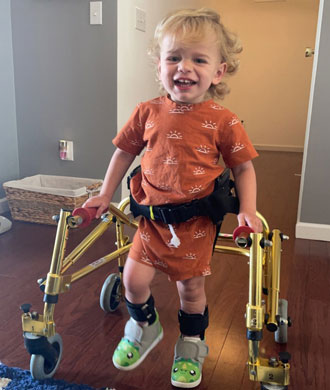
groundbreaking research to
help find a cure for LBSL, a rare genetic disease
When Dan and Stephanie Gilliam learned their son Dean, 6, had a rare form of leukodystrophy affecting his ability to move, they worried about how they’d get him the medical care he needed. But at Kennedy Krieger Institute, they found the perfect healthcare team for their family. Their second child, Dalton, 3, also has the disease.
“Kennedy Krieger has provided the resources needed to help us manage the boys’ ongoing care,” Stephanie says. “From the wonderful specialists to the informative conferences that are held, we’ve found support in their hands.”
The Gilliams fund rare disease research at Kennedy Krieger because that research, Stephanie explains, has “provided our family with hope. We will continue to give, raise funds and bring awareness to the research because it’s important in our family to find a cure. Kennedy Krieger has been a great source in doing just that.”
Research gives us hope that we will eventually identify effective therapies. Receiving donations for our work confirms that we’re doing the right thing.” – Dr. Ali Fatemi
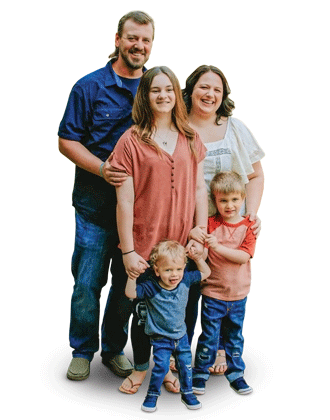
from top left: Dan, Hailey,
Stephanie, Dean and Dalton Gilliam
‘Research Gives Us Hope’
“Research is always associated with hope,” says pediatric neurologist Dr. Ali Fatemi, who serves as the Institute’s chief medical officer and directs the Moser Center for Leukodystrophies. “Research gives us hope that we will eventually identify effective therapies. Receiving donations for our work confirms that we’re doing the right thing.”
Kennedy Krieger is known internationally for its expertise in studying and treating neurological and neurodevelopmental disorders and diseases. Its renowned researchers study hundreds of conditions, many of them rare genetic diseases, each affecting fewer than 200,000—and sometimes fewer than 100—people around the world.
Finding treatments to improve quality of life and extend life for individuals with rare diseases can be challenging, because the number of people affected by each rare disease is so small. That can make it difficult to recruit enough people for a clinical study—as well as to find enough funding. That’s where donations come in.
“Donors are instrumental and essential to allowing us to initiate and continue research on rare diseases, because it’s so hard to get funding,” Dr. Fatemi says. Pharmaceutical companies and the federal government generally fund research for conditions that affect a wider percentage of the population, he explains.
But at the Moser Center for Leukodystrophies, rare genetic diseases— also known as orphan diseases—are the focus. “The mission of our research is to advance the care and health of individuals with diseases of the brain and nervous system,” Dr. Fatemi says. “And whether a disease affects 100 people or 100,000, we want to find treatments to help those individuals improve their quality of life.”
Learning About Leukodystrophies
The Moser Center is named after the late Dr. Hugo W. Moser, a pediatric neurologist and the president of Kennedy Krieger from 1976 to 1988. He and his colleagues, including his wife, Ann B. Moser, who co-directed the Institute’s Peroxisomal Diseases Laboratory, studied the genetic causes of several rare diseases, including adrenoleukodystrophy, also known as ALD, which—unless treated early and before the onset of symptoms—is fatal for affected boys. After his passing, Ann continued their work, developing a newborn screening test for ALD that is now used across the globe. Early diagnosis and intervention are saving lives.
“Ann’s contribution to this field has been gigantic,” Dr. Fatemi says. “She’s traveled around the world advocating for the establishment of the newborn screening test, and continues to make important scientific discoveries in this disease.”
Donations also fuel the center’s research on LBSL (short for leukoencephalopathy with brainstem and spinal cord involvement and lactate elevation), the condition affecting Dean and Dalton Gilliam. It’s a rare, progressive disease of the nervous system that affects a person’s ability to walk, use their arms and hands, and—eventually— talk and breathe. Only about 100 people worldwide are known to have the disease, which was first reported in 2003. As yet, there is no cure for the disease, but that’s all the more reason for Dr. Fatemi and his team to learn as much as they can about it, so that treatments— and one day a cure—might be developed.
The team recently wrapped up a study of about a dozen people with LBSL across the country (including Dean and Dalton), observing them remotely to better define the characteristics and progression of the disease. The study also determined that collecting data on people with LBSL remotely is feasible, which opens the door to better care and treatment for people with LBSL who don’t live near Kennedy Krieger.
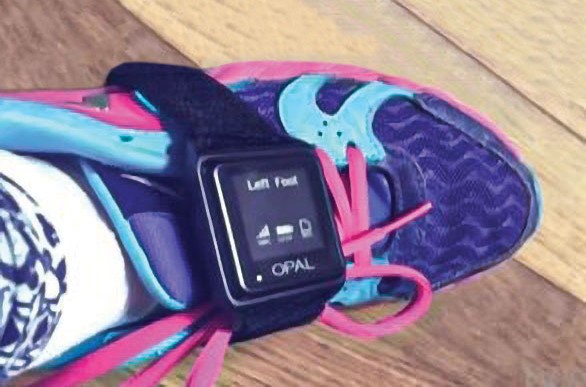
To conduct the study, the team sent out a wearable accelerometer, which looks like a wristwatch, to each participant, along with a laptop and web camera. Participants wore the accelerometer during study sessions, which were conducted via Zoom, then sent the equipment back to Kennedy Krieger. The accelerometers collected data on participants’ balance, gait and stride. Comparing the participants’ results with those of a control group, the team demonstrated that the participants with LBSL had greater instability in standing and walking—they swayed more, particularly when they had their eyes closed.
“Basically, we’re trying to understand what is happening with this disease and how people are affected, so that when we can do a clinical trial of a proposed treatment, we’ll know what to look for in terms of whether that treatment works,” Dr. Fatemi explains.
A New and Very Rare Diagnosis
Pediatric neurologist Dr. Constance Smith-Hicks conducts research on Rett syndrome and SYNGAP1-related intellectual disability, both rare disorders. The National Institutes of Health estimates that Rett syndrome, a neurological disorder, affects up to one in 22,000 people (mostly females) in the U.S. SYNGAP1, first reported in 2009, affects even fewer people—about 600 across the country—although that number continues to grow as more people are diagnosed. Individuals with SYNGAP1-related intellectual disability may have epilepsy, global delays in development, impaired cognition, sleep problems and challenging behaviors.
“We’re studying how changes in the SYNGAP1 gene affect neurologic function, and we focus on some of the common challenges seen with SYNGAP1, notably, problems with sleep and behavior. Our goals are to inform care, develop outcome measures and guide treatments,” says Dr. Smith-Hicks, who directs Kennedy Krieger’s SYNGAP1 Center of Excellence. “We’re also looking for common themes across individuals with SYNGAP1, and we’re very excited about what we’re finding.”
Her research, too, is supported in large part by private donations. “When there’s such a small study population, there is often a delay in pharmaceutical companies getting involved in the research, and that’s why we need private funding to put SYNGAP1 and other rare disorders on the map, front and center—not just that they exist, but that they impact individuals across the lifespan and around the world,” she says. “The more we can learn about rare diseases through early research, the better we can diagnose—and treat—people with these disorders.”
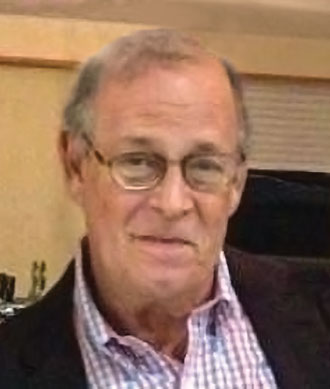
One of those donors is Dr. Norman Roskin, whose grandson, Kai, was diagnosed a year and a half ago with SYNGAP1. “For me, it’s all about finding some help for the SYNGAP1 kids,” he says. “I’ve been lucky to accumulate enough money to take care of myself and family, which enables me to make donations to various organizations” doing SYNGAP1 research.
Dr. Smith-Hicks finds that many people supporting rare disease research are like Dr. Roskin. “They want to do something that is lasting. They’re very invested in the future—not just of their family member, but of other individuals with that specific condition.” Learning that a family member has a rare disease can sometimes feel defeating, “but that’s not so for Dr. Roskin and his daughter and son-in-law. They are strong advocates for their little kiddo, and are doing everything they can to advance knowledge about the disorder at both the grassroots and academic levels.”
Dr. Smith-Hicks is thankful for any contributions donors make toward research on rare diseases at the Institute. “When we receive philanthropic donations, we know that donors see value in what we’re doing. I’m humble and grateful that someone would take their hard-earned money to support this work. It’s very encouraging,” she says.
'A Sense of Purpose’
In contrast to LBSL and SYNGAP1, sickle cell disease was first noted over a century ago. An inherited blood disorder that, untreated, can cause crises of intense pain and lead to stroke and even death, sickle cell disease predominately impacts people from Sub-Saharan Africa and parts of Asia and the Mediterranean region. In the U.S., it affects about 100,000 people, although about one in 13 Black Americans carry the sickle cell gene, explains pediatric neurologist Dr. Eboni Lance, medical director of Kennedy Krieger’s interdisciplinary Sickle Cell Neurodevelopmental Clinic and associate director of the Institute’s Neurology and Neurogenetics Clinic.
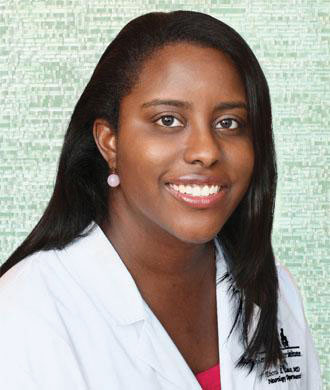
Dr. Lance is studying the different ways that sickle cell disease impacts brain functioning. In one study, she and her team are looking at cognition changes over time in kids 8 to 12 years old with the disease. They’re also studying behavioral training techniques to prepare young children (ages 6 and under) to tolerate having an MRI scan without sedation or anesthesia, which can sometimes cause complications in people with sickle cell disease.
“The behavioral training is part of the research,” Dr. Lance explains. “We hope to show that it’s possible to get MRI data on young children without putting any stress on them.”
Dr. Lance is also leading a study to learn more about how sickle cell disease affects hearing and balance. “Hearing is a major problem for people with sickle cell disease,” she says. “It’s not something that’s been studied a lot, and we’d like to find out what causes it.”
Recruiting participants for research studies on sickle cell disease can be difficult, because the community that the disease largely affects in the U.S. has been underrepresented in medical research. “We work to be sure our research is open to all comers, with all types of sickle cell disease, and that participants also get something out of the research— an MRI scan and testing results, and if they need clinical recommendations or follow-up care, we do that as well.”
Because research on sickle cell disease has been historically underfunded, there’s been less progress toward developing disease-modifying—or even curative—therapies than there has been for other rare diseases, Dr. Lance says.

But people like Jesse Brown have helped make up the difference. Jesse started donating to Kennedy Krieger in 1973, and continued contributing to the Institute every year until his passing in 2019. A medical technologist for the U.S. Army who dedicated his career to finding more efficient tests for sickle cell anemia, the most common—and often most severe—kind of sickle cell disease, Jesse established an endowment fund at the Institute to support ongoing research, and left the Institute a legacy in his will. “With the right resources, Kennedy Krieger can continue to do the important work it’s been doing all along to help these children,” he said in 2018.
Research on sickle cell disease “was very close to Jesse’s heart, and it meant a lot to him,” Dr. Lance says. “He wanted to support what we’re doing.” His legacy allowed Dr. Lance to add a neuropsychologist and an educational specialist to her research team.
“Donations such as Jesse’s allow us to explore research ideas that we might not otherwise have had the time to explore, often in a pilot study that can pave the way to new breakthroughs in clinical care. Even small donations can have a big impact in allowing us to move forward,” Dr. Lance says.
“Those donations give me a sense of purpose in that I feel I am able to be supported in the work that I truly love to do and believe in,” she adds. “It also gives me a sense of security, knowing that if we are having trouble getting funding for things, there are back-up sources that can allow me to get new, innovative projects—possibly even cutting-edge projects— off the ground. I feel an overwhelming sense of gratitude for anyone who chooses to donate, because that support is really very much needed.”











